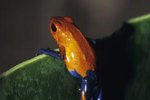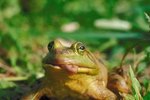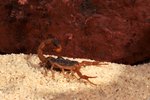Like many amphibians, toads are able to camouflage with their backgrounds and surroundings of its natural habitat. Toads can be identified from frogs due to their dry leatherlike skin and body warts. Often times toads are brownish in color and can live away from water sources. Toads use their warts and bumpy camouflaged skin to hide from predators as well as their prey.
Surinam Toad
The Surinam toad (Pipa pipa) can be found in South America and the eastern regions of Trinidad. The toad has a triangular head with dark brown spots on its light brown skin. Surinam toads can grow to up to 8 inches. These amphibians are omnivores and eat worms, crustaceans, small fish and insects. They do not have a tongue, so they use their long fingers to catch and devour food. This toad lies camouflaged at the bottom of ponds and swamps.
Marine Toad
The marine toad (Bufo marinus), also known as the cane toad, is the world's largest toad species and can be found in South America, Australia, southern Florida as well as many parts of Central America. The toad is considered a pest in Australia due to its high population. The toad has gray olive-brown skin and blends in with its dry wooded environment. This large toad secretes a dangerous venom from its glands to defend itself from predators. Marine toads are carnivorous and insectivorous foragers. They eat ants, beetles, earwigs and other amphibians.
American Toad
The American toad (Bufo americanus) is found throughout the U.S. and is native to the Neartic region, which extends from Mexico to Canada and Greenland. This species only needs water during the breeding season and is mostly active in dry humid conditions. The toad's brown skin allows it to camouflage in the dry rocky climate it inhabits. It has short legs and a stout body. Adult toads of this species are carnivorous, but the tadpoles are herbivores and only eat algae until they are young adults. Adult American toads eat beetles, snails, slugs and earthworms.
European Green Toad
The European green toad (Bufo viridis) is very versatile and can be found in fields, gardens, vineyards, deserts and parks of Eastern Europe and Asia. These insectivores eat butterflies, earthworms, caterpillars, beetles and spiders. This species of toad can live in either deserts or swamps. Its skin changes color as a response to heat and light changes. Predatory birds eat these nocturnal toads. As tadpoles, their eggs are eaten by dragonflies.
Oriental Fire-bellied Toads
Oriental fire-bellied toads (Bombina orientalis) are found in Northeast China. They live in high-elevation deciduous forests, river valleys, swamps and ponds. Its dark colored back ranges in colors from brownish-gray to bright green and helps it to camouflage with the muddy water of its habitat. The underbelly has bright red spots. This venomous toad can live up to 30 years and lays three to 45 egg clusters every seven to 10 days. This species eats molluscs, insects and worms.
References
- "Smithsonian Institution: Animal - The Definitive Visual Guide To The World's Wildlife"; Don E. Wilson; 2001
- HerpNet: American Toad - Bufo americanus
- Invasive Species Specialist Group: Global Invasive Species Database - Rhinella marina (=Bufo marinus) (amphibian)
Photo Credits
-
Photos.com/Photos.com/Getty Images
Writer Bio
Necie Reed began writing professionally in 2009. Her work appears online, focusing on topics about technology, software, video games and relationships. She also blogs and is the owner of a forum website. Reed earned her Bachelor of Science in technology from Devry University and her Master of Business Administration in project management from Keller Graduate School.




